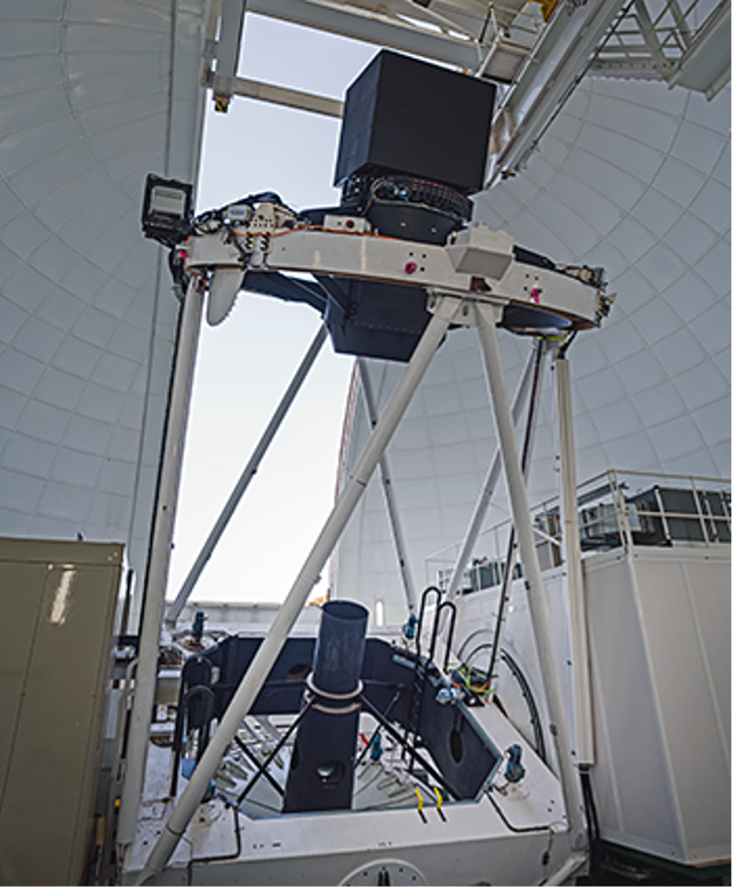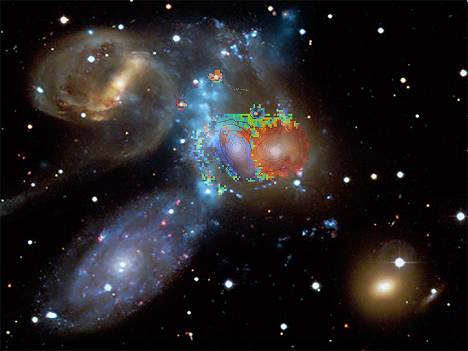Monday, 12 December 2022
Astronomers from the University of Nottingham have welcomed the first data and images taken with WEAVE, a new and unique astronomical instrument. The data taken at the Observatorio del Roque de los Muchachos (La Palma, Canary Islands) will help inform future research from the Nottingham team.
Professor Alfonso Aragón-Salamanca, from the University of Nottingham’s School of Physics and Astronomy, who leads one of the surveys that will be carried out using this instrument during the next five years, said “We have been working on this instrument and planning the science we will be doing with it for almost 12 years. It is really exciting to see the first excellent data, and know that there is much more to come – I can’t wait to get my hands on these data!”
This follows the announcement that the Isaac Newton Group of Telescopes (ING) and the WEAVE instrument team present first-light observations with the WEAVE spectrograph. WEAVE is a powerful, next-generation multi-fibre spectrograph on the William Herschel Telescope (WHT) at the Observatorio del Roque de los Muchachos (La Palma, Canary Islands) now being commissioned on-sky and already generating high-quality data.
Marc Balcells, ING Director, explains: "Our goal was to host a unique instrument that would allow astronomers to carry out cutting-edge astronomical research. It’s been fantastic to receive generous financial support from the national research agencies in the three partner countries, as well as contributions from non-ING countries. We are now happy to show that the LIFU part of WEAVE not only works, but produces high-quality data. The ING telescopes will continue to provide results of high scientific impact for years to come. We expect soon to announce subsequent first-light events for the other observing modes, now undergoing their own final tuning and calibration."
Scott Trager, Project Scientist: "These observations show the power of WEAVE to unravel the complex phenomena involved in the evolution of galaxies throughout the history of the Universe. The more than 500 members of the WEAVE Science Team and the members of the wider ING community will certainly make great discoveries with WEAVE’s exciting new capabilities."
 The William Herschel Telescope with WEAVE. The WEAVE positioner is housed in the 1.8-metre black box above the top-end ring. Optical fibres run along the telescope structure to the light-gray enclosure on the left which houses the WEAVE spectrograph. Credit: Sebastian Kramer.
The William Herschel Telescope with WEAVE. The WEAVE positioner is housed in the 1.8-metre black box above the top-end ring. Optical fibres run along the telescope structure to the light-gray enclosure on the left which houses the WEAVE spectrograph. Credit: Sebastian Kramer.
Nottingham astronomers are leading much of the unique science that will be carried out with WEAVE, taking advantage of its ability to observe the light form 1000 galaxies at the same time using its Multi-Object Spectrograph (MOS).This will allow us to map and study large portions of the sky very efficiently. Projects include:
The WEAVE Wide-field Cluster Survey will use the impressive multiplexing capability of the new instrument to address the question: “how do galaxy clusters grow?”. Galaxy clusters are the largest gravitationally bound objects in the Universe, and the WWFCS will reveal the filamentary structures surrounding them.
University of Nottingham astronomer Dr Ulrike Kuchner, who is heavily involved in the survey design and planning, said “Over the next 5 years, the WWFCS will gather spectra of over 16000 galaxies in the outskirts of 16 massive galaxy clusters. Our aim is to find the galaxies embedded in the cosmic web of dark matter and gas that surrounds these clusters on larger scales than ever before. We will be investigating how galaxies are affected by their environment throughout their lifetimes, long before gravity pulls them into the cluster cores.”
Another cornerstone of the WEAVE science case is the WEAVE-LOFAR survey, which has a broad selection of science goals, including measuring the physical processes that have shaped galaxies over the last 10 billion years of cosmic history. We will use WEAVE in its most efficient MOS mode to obtain more than a million spectra of sources chosen on the basis of their radio emission detected by the LOFAR radio telescope. This radio selection means that WEAVE-LOFAR will be very efficient, since the sample is rich with star-forming galaxies and sources dominated by black-hole accretion. The lead of the WEAVE-LOFAR survey.
Nottingham astronomer Dr Nina Hatch will receive some of the first data from the WEAVE-LOFAR survey which will be processed by University of Nottingham Physics students for their Masters research. She says, “The quality of these first data is outstanding and I really look forward to getting the data on our WEAVE-LOFAR targets. Our uniquely high resolution spectra will open a new window on how supermassive black holes affect their host galaxies."
The WEAVE LIFU measures separate spectra for 547 different regions of the two galaxies, recording the colours of their light from the ultraviolet to the near-infrared. These spectra reveal the motions of stars and gas, the chemical composition of the stars, the temperatures and densities of the gas clouds, and more. From these data, astronomers can learn how galaxy collisions transform the galaxies in the group.
First-light observations were carried out with the fibre bundle named large integral-field unit (LIFU), one of WEAVE's three fibre systems. When using the LIFU, 547 closely packed optical fibres transmit the light in a hexagonal area of the sky to the spectrograph, where it is analysed and recorded.
The LIFU was aimed at NGC 7318a and NGC 7318b, two galaxies at the heart of Stephan’s Quintet, a group of interacting galaxies. It’s been observed with Hubble, Spitzer, Chandra and other telescopes, and recently by JWST. It’s also famous for its cinematic role in the 1946 Christmas film It’s a Wonderful Life. The group, 280 million light-years from Earth in the constellation Pegasus, is undergoing a major galaxy collision and provides a natural laboratory for the consequences of galaxy collisions on the evolution of galaxies.
 The JWST image with the WEAVE LIFU pointing at Stephan's Quintet for the first-light observation. The LIFU gathers light from 547 points on the sky for analysis by the WEAVE spectrograph (each circle indicates an optical fibre 2.6 arcseconds in diameter). The observation provides physical information from each separate region of each galaxy as well as the space in between. Credits: NASA, ESA, CSA, STScI (background image); Aladin (overlay with fibres).
The JWST image with the WEAVE LIFU pointing at Stephan's Quintet for the first-light observation. The LIFU gathers light from 547 points on the sky for analysis by the WEAVE spectrograph (each circle indicates an optical fibre 2.6 arcseconds in diameter). The observation provides physical information from each separate region of each galaxy as well as the space in between. Credits: NASA, ESA, CSA, STScI (background image); Aladin (overlay with fibres).
 Blue, green and red colours, according to velocities derived from the WEAVE spectra, are overlaid on a composite image of Stephan’s Quintet, which features galaxy star light (CFH telescope), and X-ray emission of hot gas (blue vertical band, Chandra X-ray observatory). The velocities indicate that the centre-left galaxy (NGC 7318b, blue), is a late intruder, entering the group from behind at 800 km/s (nearly 3,000,000 km/h) through the centre of Stephan's Quintet. This high-speed collision creates havoc in NGC 7318b. Hydrogen gas clouds, the fuel for the formation of new stars, are being stripped off the galaxy. This will likely cause formation of new stars in the galaxy to severely slow down. The WEAVE spectra will help to figure out the fate of the stripped gas as it evolves in the space between the group galaxies.
Blue, green and red colours, according to velocities derived from the WEAVE spectra, are overlaid on a composite image of Stephan’s Quintet, which features galaxy star light (CFH telescope), and X-ray emission of hot gas (blue vertical band, Chandra X-ray observatory). The velocities indicate that the centre-left galaxy (NGC 7318b, blue), is a late intruder, entering the group from behind at 800 km/s (nearly 3,000,000 km/h) through the centre of Stephan's Quintet. This high-speed collision creates havoc in NGC 7318b. Hydrogen gas clouds, the fuel for the formation of new stars, are being stripped off the galaxy. This will likely cause formation of new stars in the galaxy to severely slow down. The WEAVE spectra will help to figure out the fate of the stripped gas as it evolves in the space between the group galaxies.
Story credits
More information is available from Dr Ulrike Kuchner on ulrike.kuchner@nottingham.ac.uk, Professor Alfonso Aragon-Salamanca on alfonso.aragon@nottingham.ac.uk
Notes to editors:
About the University of Nottingham
Ranked 24 in Europe and 15th in the UK by the QS World University Rankings: Europe 2024, the University of Nottingham is a founding member of Russell Group of research-intensive universities. Studying at the University of Nottingham is a life-changing experience, and we pride ourselves on unlocking the potential of our students. We have a pioneering spirit, expressed in the vision of our founder Sir Jesse Boot, which has seen us lead the way in establishing campuses in China and Malaysia - part of a globally connected network of education, research and industrial engagement.
Nottingham was crowned Sports University of the Year by The Times and Sunday Times Good University Guide 2024 – the third time it has been given the honour since 2018 – and by the Daily Mail University Guide 2024.
The university is among the best universities in the UK for the strength of our research, positioned seventh for research power in the UK according to REF 2021. The birthplace of discoveries such as MRI and ibuprofen, our innovations transform lives and tackle global problems such as sustainable food supplies, ending modern slavery, developing greener transport, and reducing reliance on fossil fuels.
The university is a major employer and industry partner - locally and globally - and our graduates are the third most targeted by the UK's top employers, according to The Graduate Market in 2024 report by High Fliers Research.
We lead the Universities for Nottingham initiative, in partnership with Nottingham Trent University, a pioneering collaboration between the city’s two world-class institutions to improve levels of prosperity, opportunity, sustainability, health and wellbeing for residents in the city and region we are proud to call home.
More news…